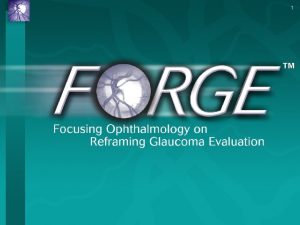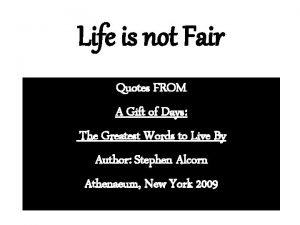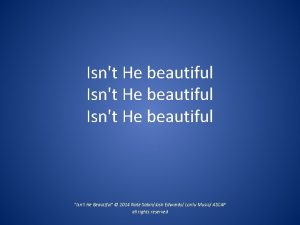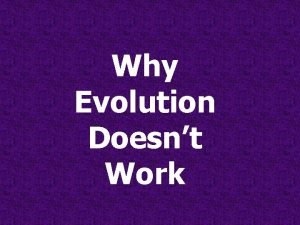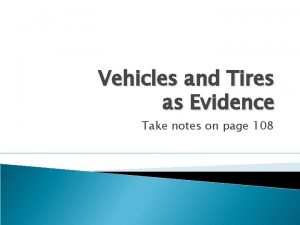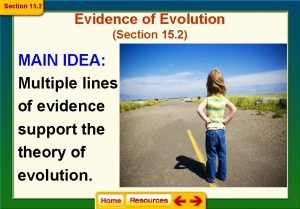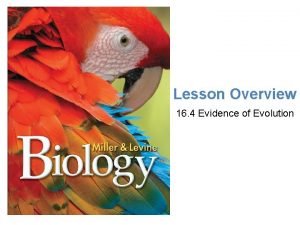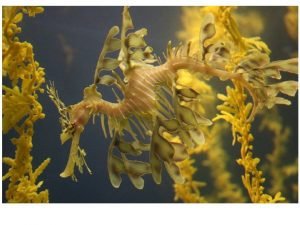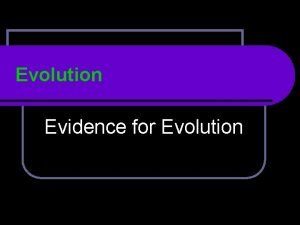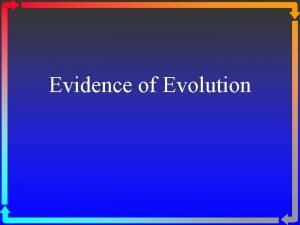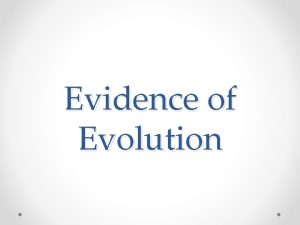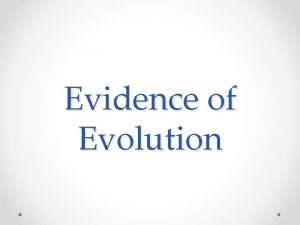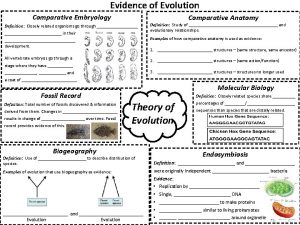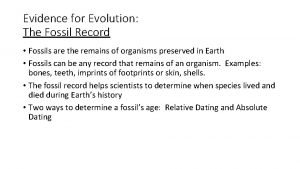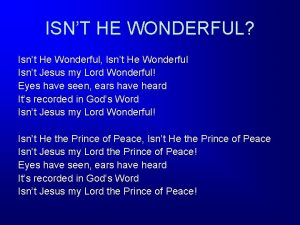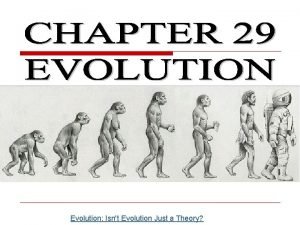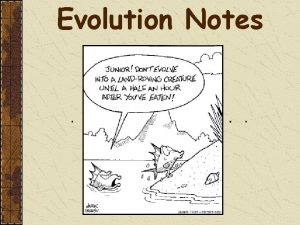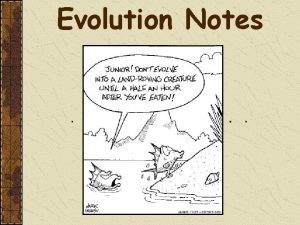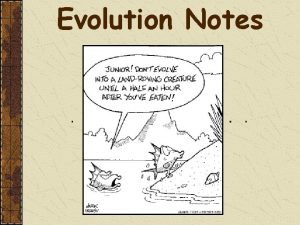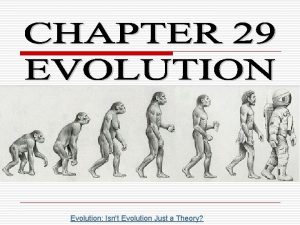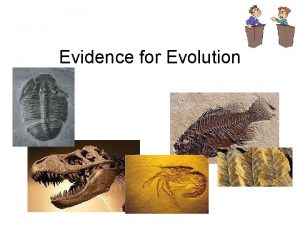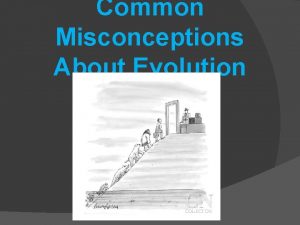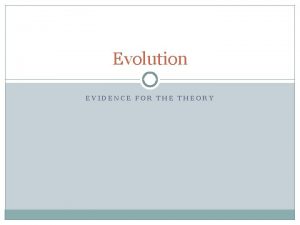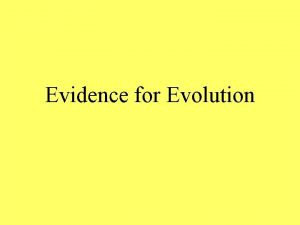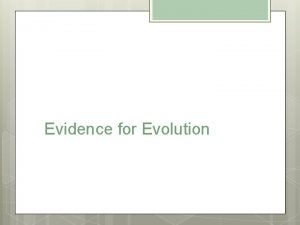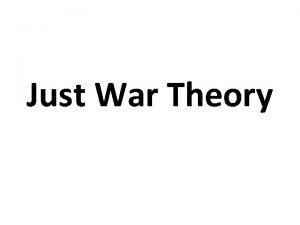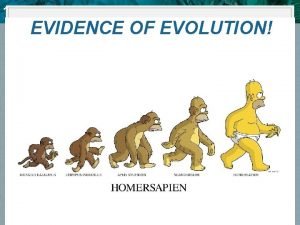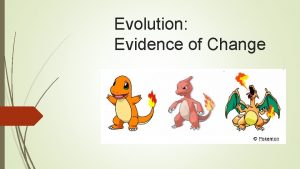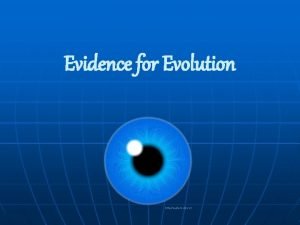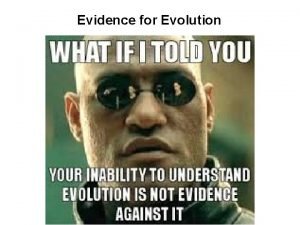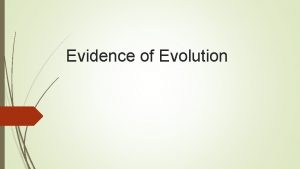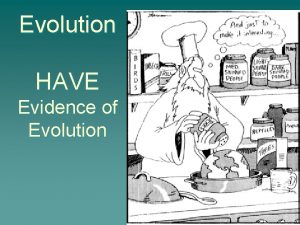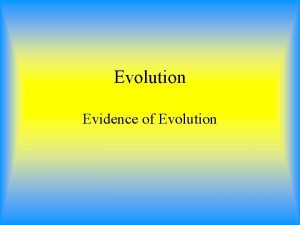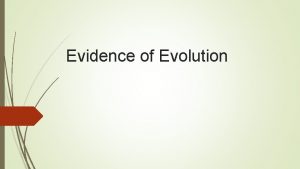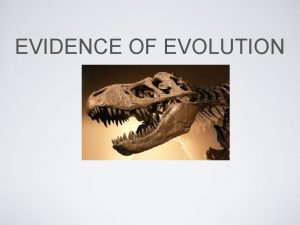Evidence for Evolution Isnt Evolution just a Theory


























- Slides: 26

Evidence for Evolution Isn’t Evolution just a Theory?

4 Categories of Evidence: Draw into Notebook Category of evidence l 1. 2. 3. Explanation/ Notes Fossil l Geographic Record l Structural Embryology l Developmental l Molecular Comparative Anatomy 4. Molecular Biology Examples

Fossils tell a story… the Earth is old Life on Earth has changed

1. Fossil Record l l l Fossils are located in sedimentary rock new layers cover older ones, which creates a record over time fossils also show that organisms have lived on Earth over a long period of time

Age of fossils Relative dating – Age determined by which layer the fossils are found in- older usually below, younger above Absolute dating- determined by radioactive dating - date in years

Why are fossils rare? l l l The environment must be favorable. Organisms must 'fall' into conditions where decay does not occur (swamps, bogs, lakes, caves). Geological processes and human activity also destroy the sedimentary rocks which contain fossils. Trilobite 526 mya Cambrian Bryozoan 450 mya Ordovician Prehistoric fish 145 mya Cretaceous

Evolution of birds Fossil of Archaeopteryx lived about 150 mya (Jurasic) l links reptiles & birds l

Whales and the Fossil Record Land Mammal ? e h t e ar ? e r Whe ediate m r e t in ? s l i s Complete series fos of transitional fossils How do we know Evolution happens Ocean Mammal ? ?


Who was Lucy? (Australopithecus afarensis) l A. afarensis skull found in 1992 – suggests that the species did not change for 900, 000 years • 3. 2 myo fossil found in Ethiopia in 1974 • she was 3’ 6”, 62 lbs. Becoming a Fossil

2. Embryology l l Study of fetal development Scientists looks at different embryos of different species and compare them with one another

l l Example: embryos of fish, salamander, tortoise, chick, rabbit, and human are similar! This shows evidence of a common ancestor Embryo’s and our Common Ancestor 12

3. Comparative Anatomy l Comparing body parts between species

Compare the bones…

Homologous structures l l Structures that come from the same origin but perform different functions Example: Forelimbs of human, cats, whales, & bats are homologous – evidence of a common ancestor

Analogous structures l l Different anatomies, but same function No evolutionary relationship

Vestigial structures l l Have no use or serve a less important function, often reduced in size Show evidence of a shared ancestry

Wisdom Teeth l l human ancestors had larger jaws with more teeth, to help chew down plants to compensate for a lack of ability to efficiently digest cellulose As human diet changed, a smaller jaw was selected by evolution, yet the third molars, or "wisdom teeth", still commonly develop in human mouths

Appendix l l vestige of the cecum, located on right side of body an organ that would have been used to digest cellulose by herbivorous ancestors

Darwin’s Tubercle l l Present in 10. 4% of the population First described by Darwin as evidence of a vestigial structure indicating common ancestry among primates

Coccyx l l l “tailbone”, remnant of a lost tail All mammals have a tail at one point in their development In humans, it is present for a period of 4 weeks (week 14 -22)

Nictitating membrane l l l Owl “third eyelid” small fold of tissue on the. Owl inside corner of the eye. present in birds, reptiles, fish, amphibians. Toad Shark Toad

4. Molecular Biology l l Comparing DNA and proteins between species That fact that we actually share specific genes and proteins, is powerful evidence of our common ancestry

Comparing genes (DNA) for eye control l Example: DNA for the eye gene between a fly, shark, squid, and flatworm is very similar!

Comparing aa sequences for hemoglobin l The less differences between species, the more closely related they are Species Amino Acid Differences from Human Hemoglobin Gorilla 1 Rhesus Monkey 8 Mouse 27 Chicken 45 Frog 67 Lamprey (jawless fish) 125

Molecular evidence allows scientists to build “family” trees
 There aren't some cakes
There aren't some cakes Notch glaucoma
Notch glaucoma Isnt the love of jesus something wonderful
Isnt the love of jesus something wonderful Not fair quotes
Not fair quotes Isnt he beautiful
Isnt he beautiful Why does juliet kiss romeo in the tomb
Why does juliet kiss romeo in the tomb What is primary sources
What is primary sources Primary evidence vs secondary evidence
Primary evidence vs secondary evidence Primary evidence vs secondary evidence
Primary evidence vs secondary evidence Primary evidence vs secondary evidence
Primary evidence vs secondary evidence Primary evidence vs secondary evidence
Primary evidence vs secondary evidence Why are fibers class evidence
Why are fibers class evidence Class evidence vs individual evidence
Class evidence vs individual evidence Why does individual evidence have high probative value
Why does individual evidence have high probative value Class vs individual evidence
Class vs individual evidence Ecological fallacy definition
Ecological fallacy definition Evidence of evolution
Evidence of evolution Evidence for evolution doodle notes
Evidence for evolution doodle notes Section 15-2 review theories of evolution
Section 15-2 review theories of evolution Common descent
Common descent Bottleneck effect
Bottleneck effect Evidence of evolution
Evidence of evolution 4 types of evidence for evolution
4 types of evidence for evolution What are the four main lines of evidence for evolution?
What are the four main lines of evidence for evolution? What are the 4 types of evidence?
What are the 4 types of evidence? Anatomy and embryology evidence of evolution
Anatomy and embryology evidence of evolution What does amber
What does amber

